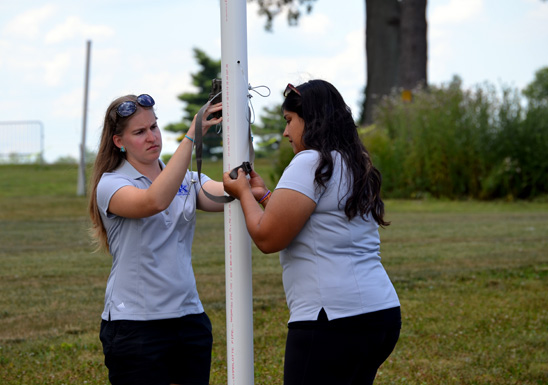UK entomology research hopes to prevent bird-plane collisions
UK entomology research hopes to prevent bird-plane collisions

The type of grass planted at airports may be able to prevent bird-plane collisions in the air.
UK entomology graduate student Diana Miller is determining if a grass variety developed in New Zealand can deter white grubs, earthworms and caterpillars, and as a result, creatures like blackbirds and gulls that feed on them. She is also interested in learning if the grass can deter Canada geese, deer and other grass-feeding wildlife that can be airport hazards.
“In 2013, the Federal Aviation Administration reported 11,000 bird strikes in the United States,” said Miller, a student in the UK College of Agriculture, Food and Environment. “In an average year, bird strikes cost the FAA $682 million in repairs and damages, and of course, there is the safety issue.”
Miller’s adviser, UK entomology Professor Dan Potter, heard about Avanex bird-deterrent grasses during a sabbatical to New Zealand. New Zealand scientists gave him seed to try in a greenhouse experiment. Results from the greenhouse study were promising. The grass Miller is evaluating—a tall fescue cultivar called Jackal—contains a novel endophyte, a type of fungus that produces chemicals that deter insects and other grass feeders. Her project at UK’s Spindletop Research Farm is the first time the grass has been field tested in North America.
Miller is testing Jackal’s ability to reduce insects and bird populations and comparing her findings to the more common KY 31 tall fescue. She is testing both endophyte- and endophyte-free varieties in each cultivar.
“Currently U.S. airports are using a mixture of grasses on their airstrips,” Potter said. “Some tall fescue is being used, but it may not have the endophyte in it.”
Miller uses wild game cameras placed along the plots to monitor the presence of birds and other small animals. In place of deer, she brought in goats to feed on the plots to determine their preference between endophytic and non-endophytic grasses. Miller monitors insects with pitfall traps in the ground and takes vacuum samples of the plots.
In addition to decreasing insect populations and flocks of insect-eating birds near runways, the bitter taste of the Avanex grass may also be undesirable to Canada geese, which feed on grasses.
If successful, the grass may have other applications beyond airstrips.
“It could be planted near ponds at parks and golf courses, where Canada geese are huge issues because of the messes they make,” Miller said. “The idea isn’t to harm the geese, just to make the grass distasteful enough that they’ll disperse and fly somewhere else, where their presence would not be a nuisance.”
Entomology Research

